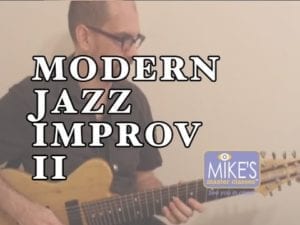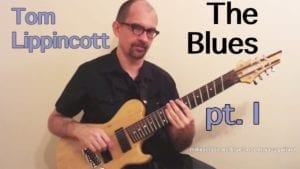Description
Music consists of three elements: melody, harmony, and rhythm. Of those three, rhythm is the element generally accepted to be the most fundamental and important. Unfortunately, rhythm is also the element that the majority of developing jazz guitarists (and most other instrumentalists) explore the least. Many guitarists have spent years honing the craft of melodic and chordal playing but still have that elusive something missing: the glue that holds everything together as a compelling, coherent musical statement. For many of these players, that missing factor is rhythm.
This class will explore rhythm in an in-depth and systematic way. Whether you are a beginning, intermediate, or advanced jazz guitarist, the concepts and exercises presented are designed to supercharge your rhythmic sense and show you how to start thinking about rhythm on the same level that you already think about melody and harmony.
In recent years, with jazz musicians incorporating sophisticated polyrhythms, odd and changing meters, and metric modulations into their music, a solid sense of time and a deep understanding of rhythm has become more important than ever for all instrumentalists, not just drummers. While part 4 of my Modern Jazz Guitar series explored the application of some of these advanced rhythmic ideas to modern-style playing, this class starts with some basic but essential concepts that have always been a crucially important part of jazz and builds on those basics to more sophisticated rhythmic skills. Beginning and intermediate jazz guitarists will benefit from Rhythm Workshop, but advanced players and those who have already been through my MJG part 4 materials will also find new and challenging concepts here.
Rhythm Workshop covers:
- Basics of jazz eighth note swing feel and why “eighth note triplets with the first two tied together” is only the tip of the iceberg
- Learning to hear and feel each downbeat and upbeat as a separate entity in a measure of 4/4 time
- 256 possible permutations of eighth notes and rests in one measure of 4/4 time, with exercises to get to know specific rhythms in an improvised context
- Discussion of the use of shading devices, phrasing, and variations in swing feel to bring single note lines to life
- Exploration of two well-known jazz blues melodies (written in standard notation and tablature with left-hand fingerings, slurs, and shading devices notated) for study of rhythmic motifs, swing feel, and swing feel variations at different tempos
- Challenging metronome exercises to build a stronger internal clock
- Explanation and exploration of triplets and triplet-based polyrhythms
- Polyrhythmic exercises that incorporate playing two rhythms simultaneously
- Technique-building exercises that address the connection between a strong rhythmic sense and good technique
- Running time: 138 minutes
- 14 pages of written examples and exercises with close-up views of the performances
- Each example performance is titled for easy navigation
- MP3 backing tracks of jazz blues and one-chord vamps at different tempos for practice of the rhythmic concepts
Rhythm Workshop Class Content | Tom Lippincott
Music consists of three elements: melody, harmony, and rhythm. Of those three, rhythm is the element generally accepted to be the most fundamental and important. Unfortunately, rhythm is also the element that the majority of developing jazz guitarists (and most other instrumentalists) explore the least. Many guitarists have spent years honing the craft of melodic and chordal playing but still have that elusive something missing: the glue that holds everything together as a compelling, coherent musical statement. For many of these players, that missing factor is rhythm.
This class will explore rhythm in an in-depth and systematic way. Whether you are a beginning, intermediate, or advanced jazz guitarist, the concepts and exercises presented are designed to supercharge your rhythmic sense and show you how to start thinking about rhythm on the same level that you already think about melody and harmony.
In recent years, with jazz musicians incorporating sophisticated polyrhythms, odd and changing meters, and metric modulations into their music, a solid sense of time and a deep understanding of rhythm has become more important than ever for all instrumentalists, not just drummers. While part 4 of my Modern Jazz Guitar series explored the application of some of these advanced rhythmic ideas to modern-style playing, this class starts with some basic but essential concepts that have always been a crucially important part of jazz and builds on those basics to more sophisticated rhythmic skills. Beginning and intermediate jazz guitarists will benefit from Rhythm Workshop, but advanced players and those who have already been through my MJG part 4 materials will also find new and challenging concepts here.
Rhythm Workshop covers:
- Basics of jazz eighth note swing feel and why “eighth note triplets with the first two tied together” is only the tip of the iceberg
- Learning to hear and feel each downbeat and upbeat as a separate entity in a measure of 4/4 time
- 256 possible permutations of eighth notes and rests in one measure of 4/4 time, with exercises to get to know specific rhythms in an improvised context
- Discussion of the use of shading devices, phrasing, and variations in swing feel to bring single note lines to life
- Exploration of two well-known jazz blues melodies (written in standard notation and tablature with left-hand fingerings, slurs, and shading devices notated) for study of rhythmic motifs, swing feel, and swing feel variations at different tempos
- Challenging metronome exercises to build a stronger internal clock
- Explanation and exploration of triplets and triplet-based polyrhythms
- Polyrhythmic exercises that incorporate playing two rhythms simultaneously
- Technique-building exercises that address the connection between a strong rhythmic sense and good technique
- Running time: 138 minutes
- 14 pages of written examples and exercises with close-up views of the performances
- Each example performance is titled for easy navigation
- MP3 backing tracks of jazz blues and one-chord vamps at different tempos for practice of the rhythmic concepts
| Rhythm Workshop | |||
| Rhythm Workshop | 02:19:00 | ||





